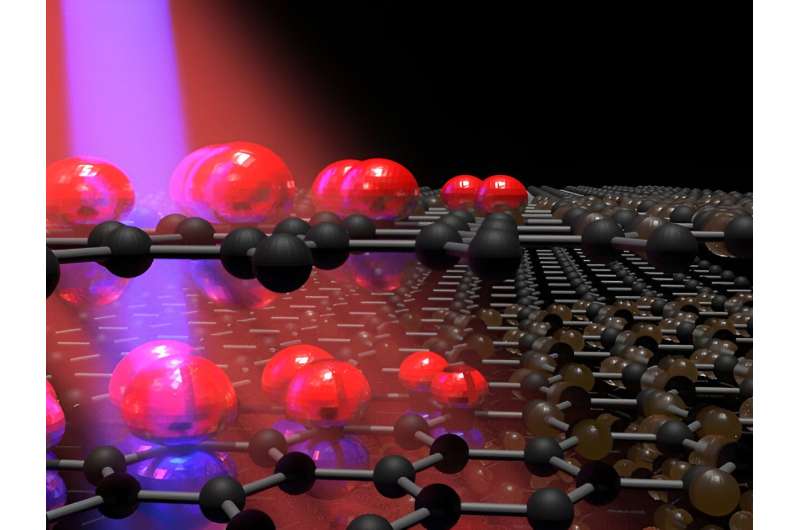
X-ray absorption spectroscopy is an element-selective and electronic-state sensitive technique that is one of the most widely used analytical techniques to study the composition of materials or substances. Until recently, the method required arduous wavelength scanning and did not provide ultrafast temporal resolution to study electronic dynamics.
Over the last decade, the Attoscience and Ultrafast Optics group at ICFO led by ICREA Prof. at ICFO Jens Biegert, has developed attosecond soft-X-ray absorption spectroscopy into a new analytical tool without the need for scanning and with attosecond temporal resolution.
Attosecond soft-X-ray pulses with a duration between 23 attoseconds (as) and 165 as and concomitant coherent soft-X-ray bandwidth from 120 to 600 eV allow interrogation of the entire electronic structure of a material at once. The combination of time resolution to detect electronic motion in real-time and the coherent bandwidth that registers where the change happens provides an entirely new and powerful tool for solid-state physics and chemistry.
One of the most fundamentally important processes is the interaction of light with matter, e.g., to understand how solar energy is harvested in plants or how a solar cell converts sunlight into electricity. An essential aspect of material science is the prospect of altering the quantum state, or the function, of a material or substance with light.
Such research into the many-body dynamics of materials addresses core challenges in contemporary physics, such as what triggers any quantum phase transition or how properties of materials arise from microscopic interactions.
In a recent study published in Nature Communications, ICFO researchers Themis Sidiropoulos, Nicola Di Palo, Adam Summers, Stefano Severino, Maurizio Reduzzi, and Jens Biegert report on having observed a light-induced increase and control of the conductivity in graphite by manipulating the many-body state of the material.
Attosecond pump-probe measurement of the light-matter hybrid
The researchers used carrier-envelope-phase-stable sub-2-cycle optical pulses at 1850 nm to induce the light-matter hybrid state. They probed the electronic dynamics with attosecond soft-X-ray pulses with 165 as duration at the carbon K-edge of graphite at 285 eV. The attosecond soft-X-ray absorption measurement interrogated the entire electronic structure of the material at attosecond-interval pump-probe delay steps.
The pump at 1850 nm induced a high conductivity state in the material, which only exists due to the light-matter interaction; thus, it is called a light-matter hybrid.
Researchers are interested in such conditions since they are expected to lead to quantum properties of materials that do not exist otherwise in equilibrium, and these quantum states can be switched at essentially optical speeds up to many THz. It is, however, largely unclear how the states exactly manifest inside materials.
Thus, much speculation exists in recent reports on light-induced superconductivity and other topological phases. ICFO researchers used soft-Xray attosecond pulses for the first time to “look inside the material” as the light-matter state manifests.
The first author of the study, Themis Sidiropoulos, notes, “the requirement for coherent probing, attosecond time resolution and attosecond synchronization between pump-and probe is entirely novel and an essential requirement for such new investigations enabled by attosecond science.”
Unlike twistronics and twisted bilayer graphene, where experimentalists manipulate the samples physically to observe the changes in the electronic properties, Sidiropoulos explains that “instead of manipulating the sample, we optically excite the material with a powerful light pulse, thus exciting the electrons into high energy states and observe how these relax within the material, not only individually but as a whole system, watching the interaction between these charge carriers and the lattice itself.”
To see how the electrons in the graphite relaxed after the strong pulse of light was applied, they took the broad X-ray spectrum and observed, firstly, how each energy state relaxed individually and, secondly, how the whole electron system was excited, to observe the many-body interaction between light, carriers, and nuclei at different energy levels.
By observing this system, they could see that the energy levels of all the charge carriers indicated that the material’s optical conductivity increased at a point, showing signatures or reminiscence of a superconductivity phase.
How were they able to see this? Well, in fact, in a previous publication, they observed the behavior of coherent (not random) phonons or collective excitation of the atoms within the solid.
Because graphite has an array of very strong (high energy) phonons, these can efficiently transport significant amounts of energy away from the crystal without damaging the material through mechanical vibrations of the lattice. And because these coherent phonons move back and forth, like a wave, the electrons within the solid seem to ride the wave, generating the artificial superconductivity signatures that the team observed.
The results of this study show promising applications in the field of photonic integrated circuits or optical computing, using light to manipulate electrons or control and manipulate material properties with light.
Biegert says, “Many-body dynamics are at the core, and, arguably, one of the most challenging problems of contemporary physics. The results we have obtained here open a new realm of physics, offering novel ways to investigate and manipulate correlated phases of matter in real-time, which are crucial for modern technologies.”
